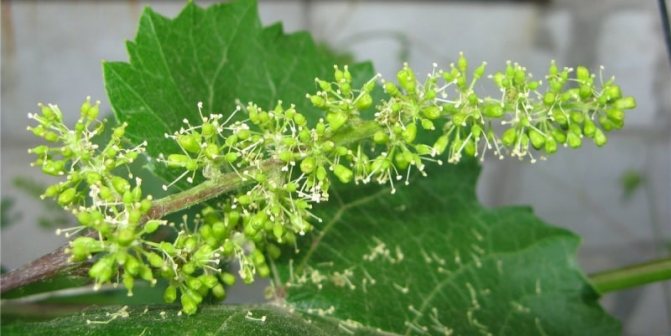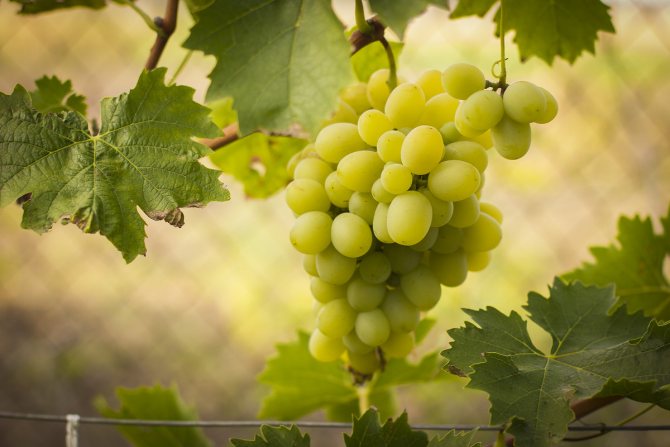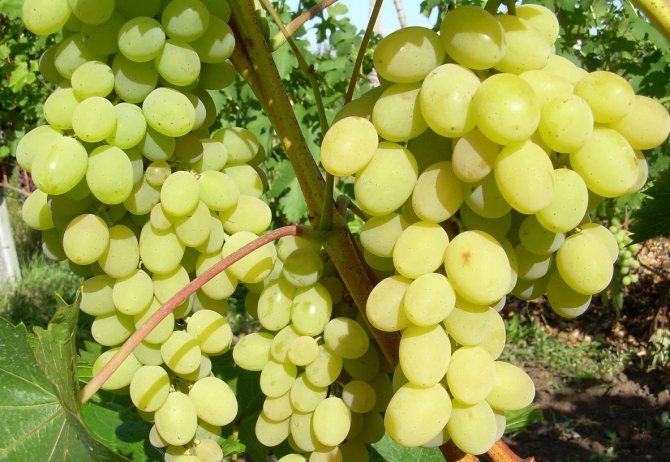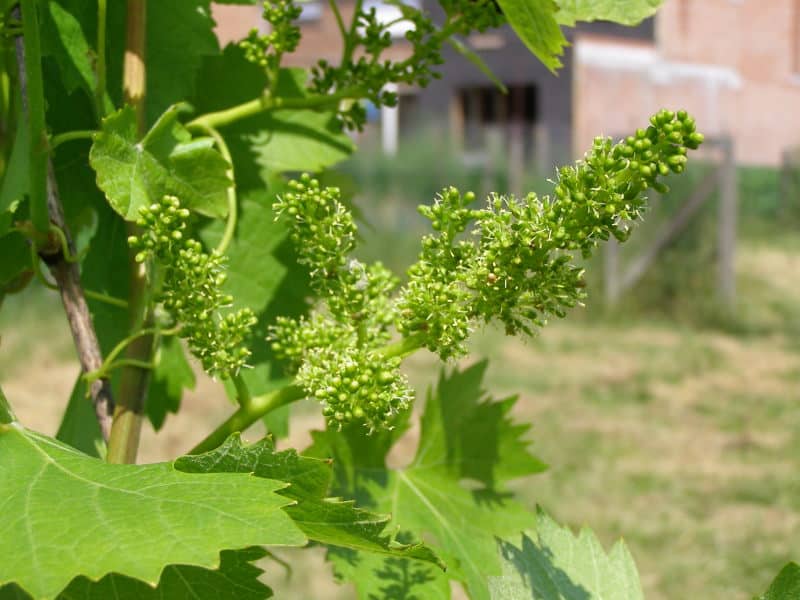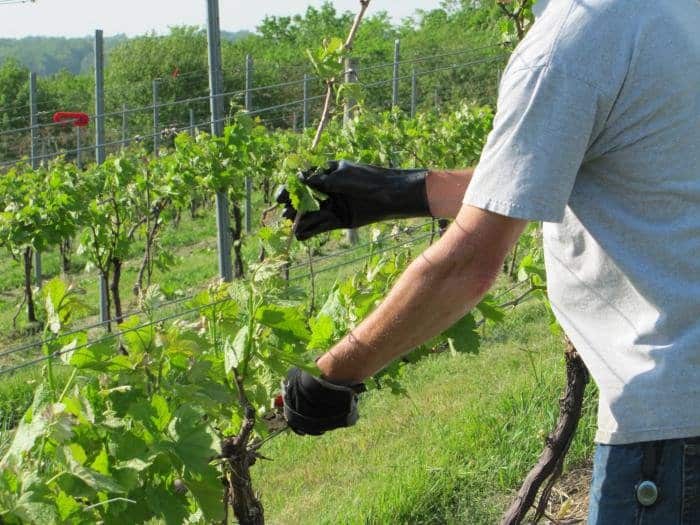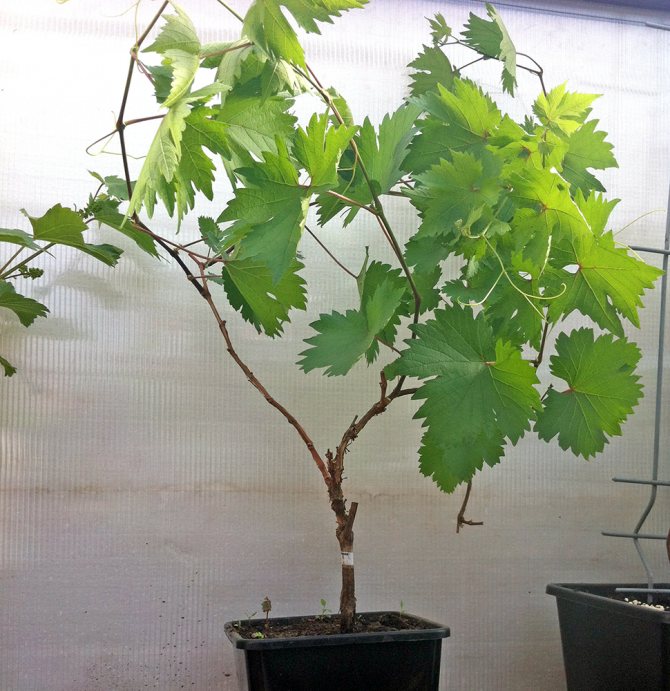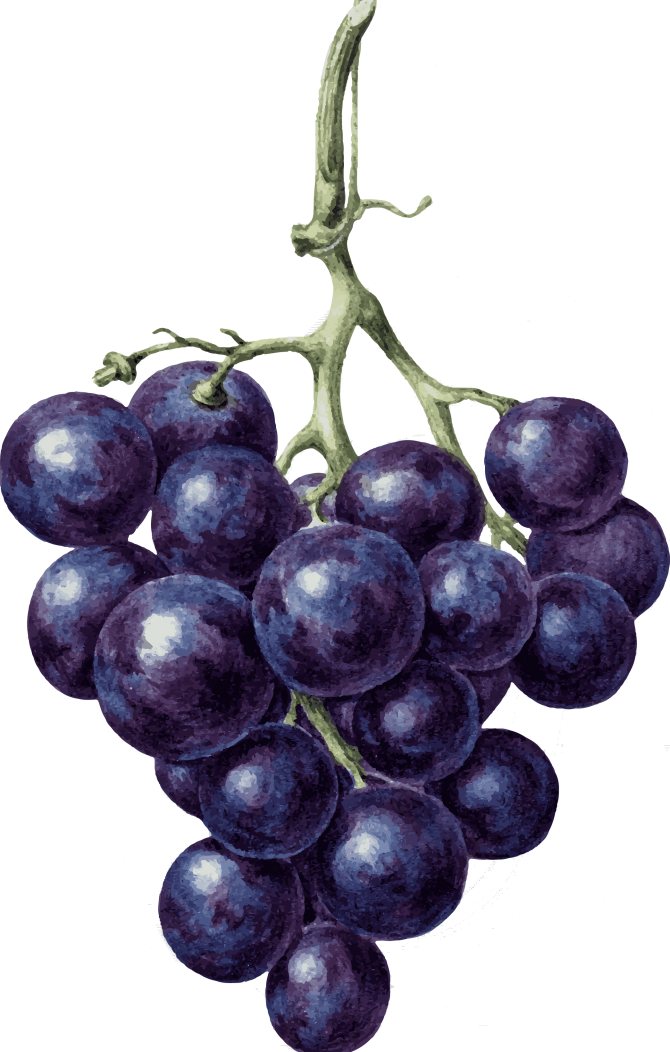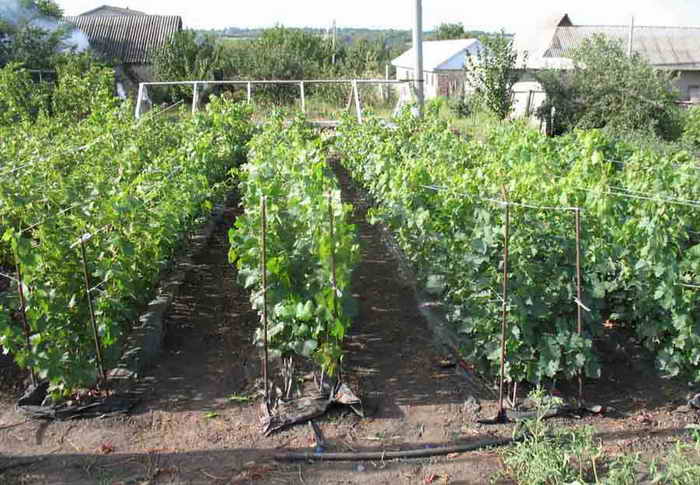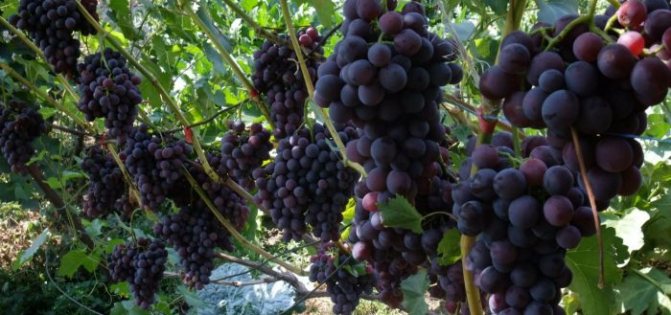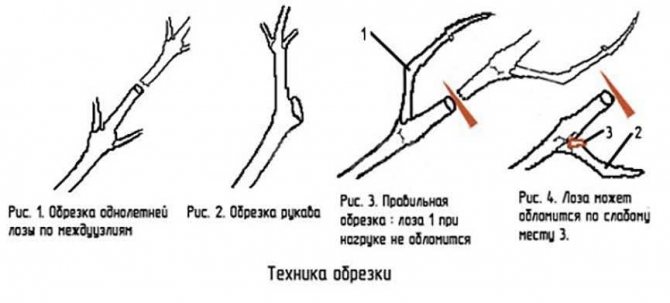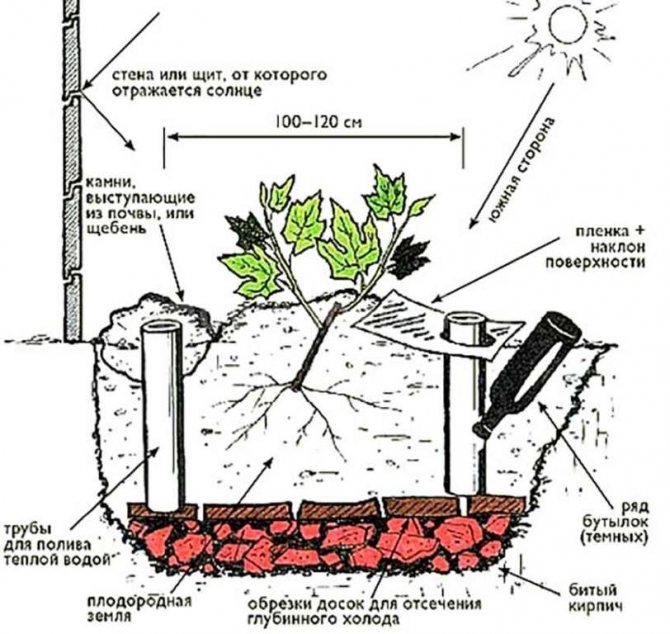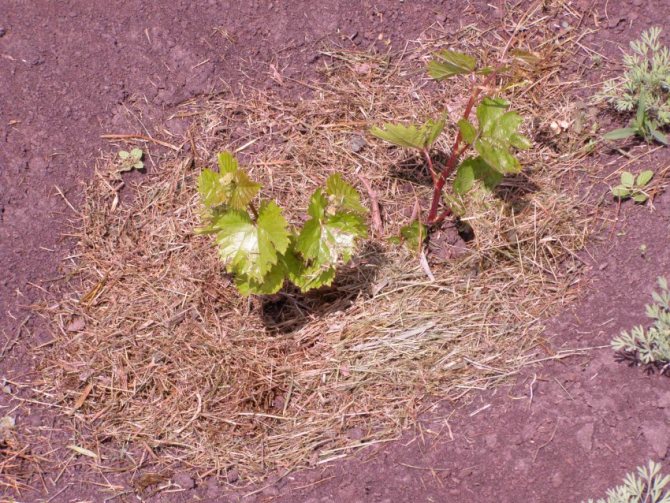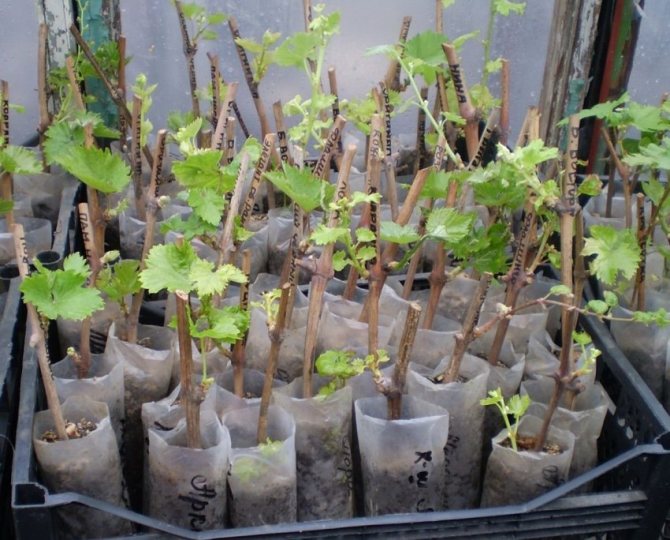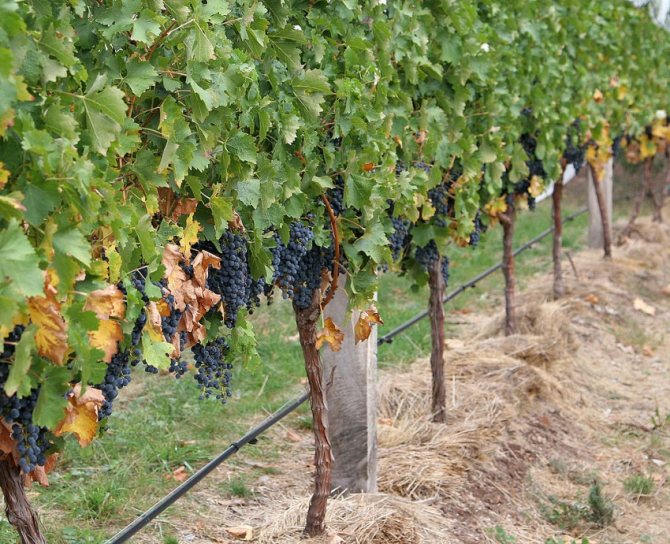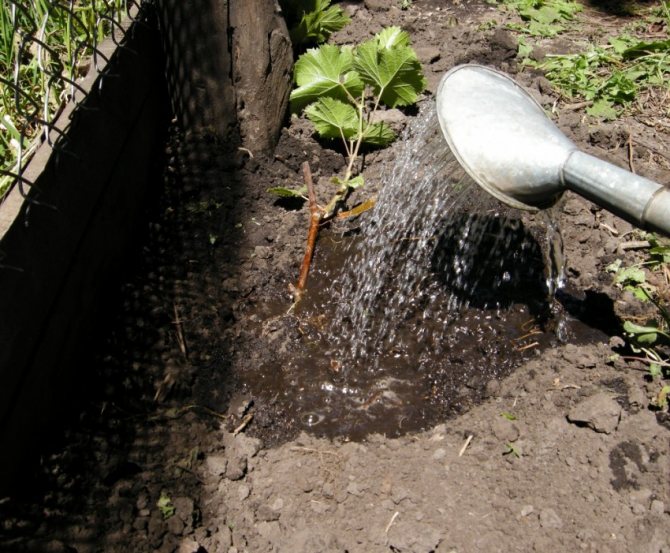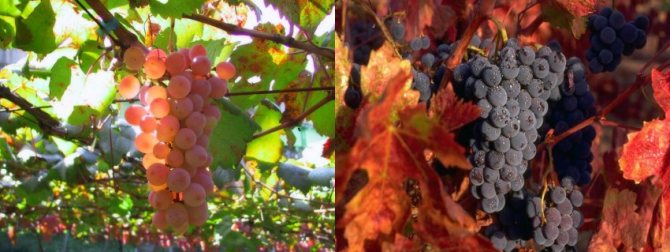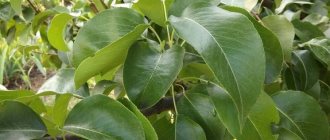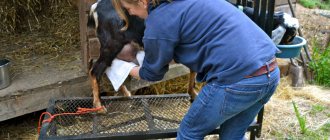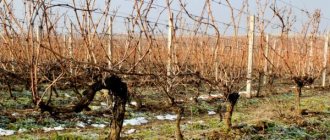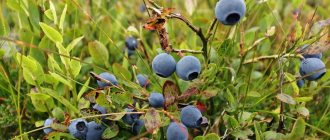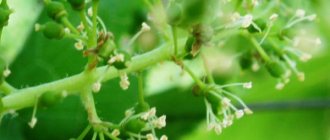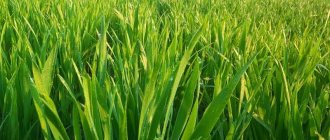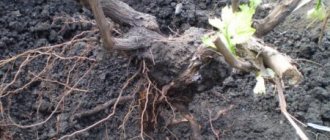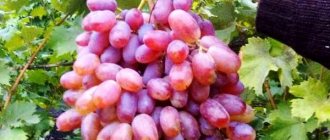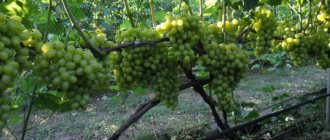Having planted grapes, everyone who loves these berries asks the main question, for what year does the grape bear fruit after planting? Everyone dreams of getting at least a small harvest in a short time interval: both beginners and professionals involved in planting crops and caring for grapes for a long time.
Early fruiting depends on many factors, although the standard normal yield is given by the planted plant only in the fourth year of its life. And then only with proper and high-quality care.
It is this period that grapes need in order to form a strong root system, a powerful upper part, and a plentiful ovary. This is how the culture planted for industrial purposes begins to bear fruit.
Although, with the use of certain options for caring for the plant, the appearance of the first bunches is possible already for 2-3 years. How this can be achieved at home will be discussed in this article.
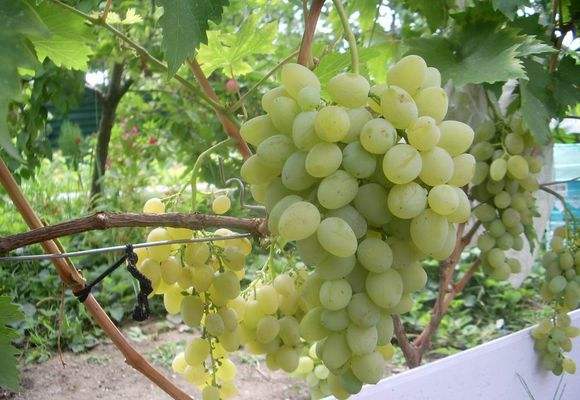
Planting grape seedlings for beginners - preparation for the procedure
First of all, young vines need to be hardened. Even if the seller convinced you that he performed all the procedures on his own, it is better to play it safe. After all, seedlings that have not been hardened, take root worse and get sick more. You can wait for a harvest from them longer or they will die altogether, without even growing.
The procedure is carried out as follows: keep the seedlings in fresh air every day for about 2 weeks. Start at a quarter of an hour on the first day and then increase the time by 30 minutes each day. Protect the vine from the sun for the first week. The last 3-4 days, the grapes should be constantly in the fresh air. Exception: forecasted frost, which could kill the seedlings.
It is worth planting grapes only after the end of return frosts. The most favorable time: May - early June, when the soil has already warmed up well. The ideal time to board is morning or evening. It is better to choose a cloudy day so that the plant takes root faster.
After planting grape bushes, many gardeners wonder what year the grapes give their first harvest. In most cases, it takes 4 years from the moment of planting to fruiting.
In practice, the situation is somewhat different, since a lot here depends on care, on the climate of the region where the culture is growing.
When asked how old grapes live, the answer ranges from 60 to 170 years.
The term for the formation of fruits largely depends on which agricultural technique is chosen. On an industrial scale, the first crop will be harvested after 4 years. For these purposes, the following varieties are most often planted:
- Veles,
- Long,
- Isabel,
- Kishmish,
- Summer Muscat,
- Noble.
Large areas are allocated for vineyards, and therefore the formation of shrubs occurs so that later you do not have to spend a lot of time caring for the vines and at the same time receive the maximum amount of harvest. Therefore, for the first 3 years, formative pruning is carried out, only a couple of main vines remain on the bushes.
During the formation of the grapes, it will not bear fruit. But such agrotechnology makes it possible to perfectly strengthen cultural plantings and give large yields in the future. In addition, shrubs formed in a similar way will not need to be watered often, and this is a certain convenience for industrial production.
Fruiting vine
Important! If the grapes bear fruit in the early years, then the bush noticeably weakens. To increase resistance to various diseases, it is recommended to pick the first flowers.
What year does the grape bear fruit after planting? This happens 4 years after the plant takes root. As soon as the first roots are formed at the cutting, you can start counting the time. However, there are a number of factors that contribute to the acceleration or postponement of the time of fruit collection.
If you plant grape cuttings in a permanent place in February, then the first bunches of the crop are obtained in 2 years.
Yielding grape varieties are unpretentious to the quality of the soil, but they do not tolerate swampy and too salty soils. Even if you do not take some care, the fruitfulness of the shrubs will not go anywhere, but the berries will be small in size, and the ripening period will noticeably increase.
When grapes begin to bear fruit after planting and what factors affect this:
- the quality of the planting material;
- landing site;
- regional location of vineyards;
- the time when the landing is made;
- number of waterings;
- fertilization;
- shrub formation;
- diseases and pests.
Subtleties of care
How many years does a vine live? The term depends on the care of the shrubs. An excess amount of water leads to numerous gains, and there is no longer enough strength for the formation of fruits. If the vines do not ripen, the buds will freeze in winter. Insufficient watering also negatively affects the well-being of the grapes, and therefore it is recommended to observe moderation.
Grape seedling
Various fertilizers can be applied during watering. The most commonly used mineral and organic feed. Organic matter is applied every 3 years, as well as phosphorus and potassium. In the spring months, they are limited to compost, and with the onset of autumn, manure is introduced.
Important! In the spring, it is recommended to feed the grapes before the winter shelters are removed from the bushes.
For plant health during the growing season, fertilizing is applied three times:
- the first time in the spring months before flowering begins;
- the second time, so that the ovaries form well before the formation of flowers;
- the third time before the fruits begin to ripen.
Some grape varieties deserve special attention due to the fruiting period.
Augustine
This variety is suitable for both experienced gardeners and beginners. Due to the early ripening of the bunches and frost resistance, people engaged in viticulture in the zone of Siberia and the Urals prefer Augustine.
One bunch can weigh 0.4 - 1 kg. The berries are not tightly pressed against each other, despite the size. One grape can weigh about 8 g and have a diameter of up to 2.8 cm. The skin is white or yellowish.
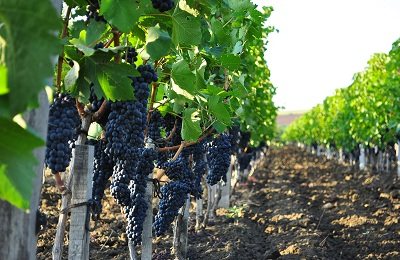

On a note! A vine can live 60 to 80 years.
When do grapes give their first harvest? You can get ripe fruits from adult shrubs on day 117. If you leave one inflorescence on each shoot, then the ripening period of the berries is reduced by 10 days.
Augustine
Aleshenkin
Gardeners interested in growing grapes in the Moscow region should pay attention to this particular variety. Aleshenkin is an unpretentious grape, it is easy to grow, while getting a high quality harvest. The benefits include the following features:
- obtaining early bountiful harvests;
- amazing taste of grapes;
- there are very few seeds in berries;
- cuttings root perfectly;
- the harvest ripens even if the weather conditions are unfavorable.
Arcadia
The second name of this variety is Nastya. If you provide the shrubs with proper care, then you can get high yields. The berries on the vines are large and have a pleasant nutmeg aroma.The peculiarities of the variety include excellent adaptation to different climatic zones, and sharp temperature changes do not harm the culture.
Arcadia
The positive sides of Arcadia are the following features:
- early ripeness, from the moment the flowers appear until the first brushes ripen, it takes about 120 days;
- large berries: one grape can weigh about 15 g. The color of the technical ripeness of the berries is white, light yellow, the amber color of the grapes indicates biological ripeness;
- the peel is thin, has a whitish waxy coating; inside the berries there is a fleshy juicy pulp.
How long does this variety grow before fruiting? It all depends on how the landing was made. If cuttings were chosen, then the second year is characterized by the appearance of signal bunches, which are recommended to be left in an amount of 2 pieces so that the berries do not overload the bushes. But from the third year, full-fledged fruiting of the culture begins.
To get a good harvest in the early stages, many factors must be taken into account, as well as provide the grapes with proper care. We are talking about the correct selection of the place, watering, pruning and treatment from diseases and pests. Only then can the gardener count on remuneration for the work done.
What determines the start of fruiting
Each gardener, acquiring a new fruit or flowering seedling, immediately draws in his imagination a plant in all its glory. Having planted grapes, you want to taste its delicious juicy berries as soon as possible. But when will the first fruits be expected?
So, how long after planting does the grape begin to bear fruit? The length of time from planting to first fruiting varies. In industrial vineyards, the first crop is harvested after four years. Such a long period is due to the cultivation technique.
Industrial vineyards cover whole hectares of land. Accordingly, they are formed in such a way that in the future they spend a minimum of time on a bush, and get the maximum yield. For this purpose, formative pruning is carried out for the first three years.
Only two main vines are left. Accordingly, while the bush is subject to formation, it does not bear fruit. But it is perfectly strengthened and in the future it steadily gives a large harvest.
Vineyards formed in this way do not need frequent watering, which is very convenient on an industrial scale.
Important! Fruiting in the early years weakens the shrub. To make it resistant to diseases and conditions, it is better to pick off the first bunches.
It is believed that the grape bush begins to bear fruit four years after rooting. That is, from the moment the first roots appear at the cutting, you can start counting. However, some factors, including the actions of gardeners, can both speed up and postpone the moment of harvesting.
On average, grapes begin to bear fruit in the third year after planting, and you can get a bountiful harvest already in the fourth.
After planting the grape cuttings in a permanent place in February, you can get the first harvest in the second year.
Planting and caring for the vineyard carried out according to the rules will allow you to enjoy the first berries already 2-3 years after planting. But it so happens that gardeners cannot achieve a harvest even in the 5-6th year, since the fruiting of a crop depends on many conditions that were not taken into account when planting grape bushes.
There are several factors that affect the rate at which berries form.
Seat selection
The culture is very demanding on the place of growth, therefore, when choosing a site, one should give preference to well-lit by the sun and areas that are reliably protected from drafts.
It grows poorly, the plant will develop in cool lowlands and at the foot of the slopes. Groundwater should approach the surface no more than 2.5 m.It is not recommended to place the vineyard next to fruit trees, as the plants will begin to compete for survival, this will negatively affect the yield.
Landing dates
The first rule of successful growth, fast fruiting and high annual yields is timely planting. Since the air temperature and weather will depend on how quickly the seedlings will take root and develop in the future.
Planting work should be carried out in the spring, when the soil warms up to 15 degrees. During the summer period, the roots adapt, this will allow the plant to survive the winter without problems.
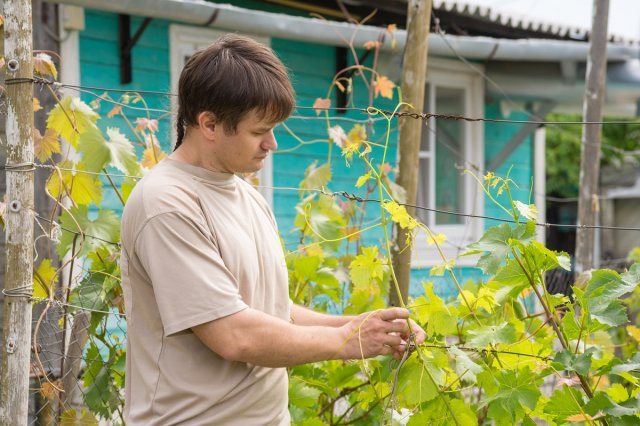

The disembarkation time depends on the climatic conditions of the region. In the southern regions, planting is recommended in February, in server latitudes - in April, May.
Pruning
An important agricultural technique in obtaining a healthy plant is pruning, the purpose of which, during the period of accumulation of the vegetative mass of the bush, is to create a strong skeleton and well-developed annual shoots, as well as to shape it in accordance with the ecological growing conditions.
Important! By cutting off the grapes shortly, you can slow down its fruiting, and ignoring the procedure, ripening will be delayed, since the plant will spend a lot of energy on weak, unnecessary shoots.
Top dressing
The ripening of the vine depends on the amount of nutrients that are supplied during the growing season. Top dressing using organic, mineral fertilizers will have a good effect on the rate of ripening of the crop. Apply organics, phosphorus and potassium once every 3 years. In the spring, limit yourself to compost, and in the fall, enrich the soil with manure.
Also, culture can tell what nutrients it needs. If the growth of grapes slows down, and the foliage becomes smaller and falls off prematurely, this signals a nitrogen deficiency. Lack of phosphorus causes darkening and lethargy of the leaves, and the loss of taste of the berries and yellowing of the leaves are considered a sign of a lack of potash fertilizers.
When growing, it is important to choose the right grape variety, taking into account the climatic conditions in which it will grow. To do this, you need to understand the ripening time so that the selected variety has enough heat for full ripening. Also take into account frost resistance and resistance to fungal diseases.
It is better to give preference to seedlings grown in natural and climatic conditions close to those in which it will be further cultivated.
Diseases and pests
Among the pests of grapes - spider mite, phylloxera. These insects are capable of destroying crops in a short time. Diseases of grapes inhibit its development and fruiting, and can also cause the death of grapes.
Preventive procedures are considered effective measures in solving problems:
- Regular removal of weed vegetation and loosening of the soil will prevent pest larvae from settling in it.
- Spring treatment before budding of bushes from diseases, parasites using universal insecticides.
- Deep digging of the soil around the grapes in the fall, after the harvest and foliage fall. This operation promotes aeration of the root system, moisture retention, and the destruction of hibernating larvae.
- With the appearance of diseases and pests, timely implementation of the correct treatment, namely the elimination of infected parts of the plant, collection and subsequent burning of fallen leaves from infected bushes.
Taking preventive measures will help not only keep the vine healthy, but also shorten the waiting period for fruits.
Grapes are a fairly unpretentious plant to the soil. He categorically does not tolerate only swampy and highly saline soil. Without some care, the shrub will yield a harvest, but the berries will be small, and their ripening time will be late.
There are several factors that affect the rate of fruit emergence.
- Planting material.
- Landing site.
- Region.
- Landing time.
- Watering.
- Lack or excess of nutrients.
- Pruning.
- Diseases and pests.
As with every plant, there are many factors influencing the rate of development of grapes. Let's take a closer look at each of them.
What year?
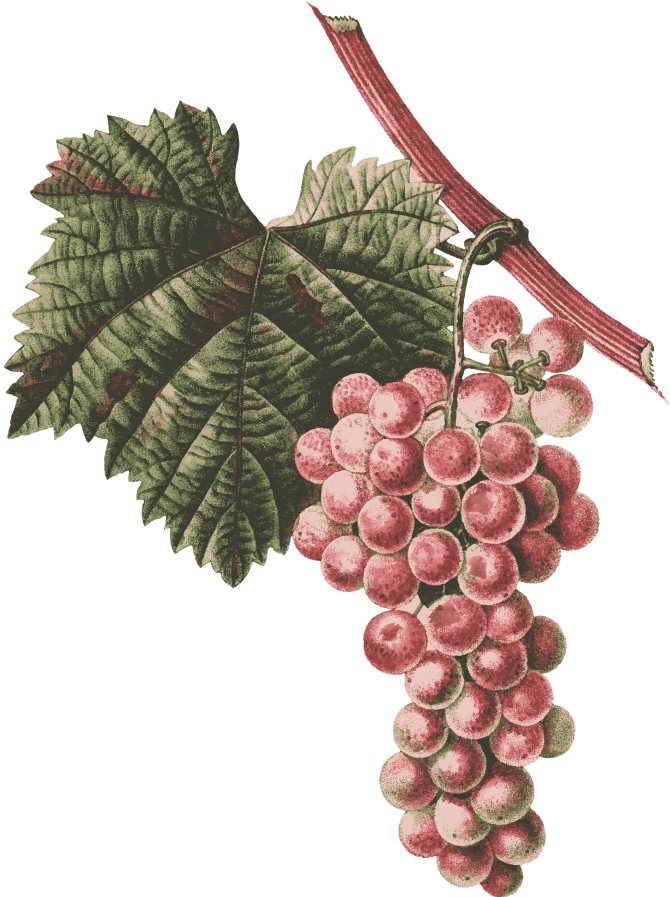

First
In the first year after planting, it is necessary to provide the plant with proper care with careful observance of the conditions of agricultural technology. The main task in the first year is to grow a healthy vine. and carry out high-quality pruning. It depends on these conditions in how many years it will begin to bear fruit and whether there will be a harvest at all in the following years. At this stage of development, the flowers are cut off.
Second
In the second year, the vine begins to bear fruit, but since two-year-old grapes have 3-4 branches, the bunches of grapes will be large (depending on the variety), but their number will be less than that of an adult vine. With good care, you can achieve a yield 2 times less than that of a vine that has ripened in subsequent years.
The third
In the third year, the bush has already grown stronger, the root system has grown, and fruiting will be in accordance with the yield indicators of each variety. On average, the yield will be 15-20 kg per bush.
Yield growth increases every year for 8-9 years fruiting bush. After that, the yield indicators gradually decrease until the bush is rejuvenated.
Grapes - planting and care in the open field
While the seedlings are hardening, dig quality planting holes. The width, length and depth are on average 80 cm, but you can adjust the parameters in accordance with the size of the site and the composition of the soil.
If the site has light fertile soil, planting holes for grapes can be dug out very small, and if heavy clay, their size should be as large as possible.
Divide the earth dug from the hole into three parts. The most fertile soil from the top layer, which is about 20-30 cm, you will later put on the bottom of the pit, closer to the roots. Then the middle part of the soil will be used. And on top - the least nutritious soil from the lower layer, which after a while will again become fertile after the action of soil bacteria.
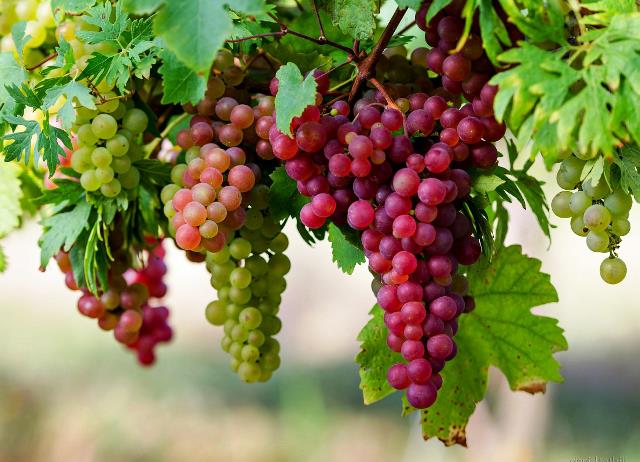

When digging a hole, carefully inspect the clods, remove pest larvae and plant roots that can interfere with the development of the vine. Then pour into the hole:
- 2 buckets of rotted organic matter: manure, compost;
- 1.5 kg of wood ash;
- 300 g of complex feeding, for example, nitroammophoska.
Mix everything thoroughly with a long stick, having previously poured the top layer of fertile soil, and pour 2 buckets of water. When the moisture has been absorbed, pour soil from the middle layer of the pit.
It is better not to use nitrogen fertilizing in its pure form, otherwise the vine will begin to fatten, its ripening and resistance to frost will decrease.
If the weather was unfavorable or you did not have time to prepare the holes, the grape seedlings can be saved for autumn planting. Just transplant them into containers with drainage holes and dig them into the ground to the middle, water regularly. This gives you more time to get ready for the fall planting.
Spring grape care consists in combating diseases, pests and unfavorable external factors. For protection, spray the plant with 1% Bordeaux liquid, which will prevent the development of fungal diseases. Ordinary laundry soap (1 piece per 10 liters of water) will help with grape moths, fleas and spider mites.
Taking care of grapes in summer consists in regular watering and feeding, loosening the soil and weeding.
After planting, the vine needs regular and abundant watering. Of course, how often you water your grapes depends primarily on the weather. But usually the plant is watered 10-15 days after planting and the procedure is repeated every 2 weeks. If it is hot and the earth dries up quickly, watering is increased.
For watering grapes, use warm, settled water in a volume of 5-10 liters per bush.
Fertilizers that were applied during planting will provide the vine with nutrients for 2-3 years, so there is no urgent need for additional feeding. If desired, at the end of summer, you can reinforce the plant with the following mixture: 10 g of potassium sulfate and 20 g of superphosphate per 1 sq. M. Then the grapes are better prepared for winter.
Pruning grapes
The main purpose of pruning in the first year after planting is to give the bush the right "direction" of growth so that it has two new strong shoots. To do this, immediately after planting, cut it to 2 eyes, removing everything else.
In the future, grapes are pruned annually. Otherwise, thickened plantings will become a source of diseases and pests, and the yield will sharply decrease.
You can also carry out catarovka - removal of the surface roots of the plant. This will allow the other roots to go deeper into the ground and overwinter successfully. Outline the hole up to 25 cm deep and carefully trim off the top roots and excess shoots. Then cover the hole with earth.
For the winter, young bushes must be covered, regardless of whether you have a winter-hardy variety or not. The procedure is carried out when all the leaves fall off, after the first small frosts. For shelter, you can use straw, spruce branches, spunbond and even slate.
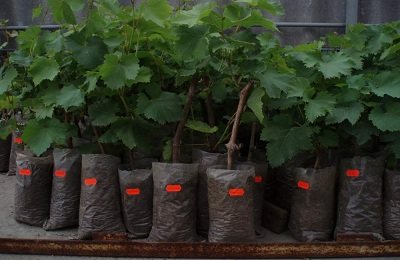

If you observe the correct watering of the grapes, regularly feed the vine and protect it from pests, then the young plant will develop as well as the seedlings planted last fall.
Do you want to grow grapes? The beginner cares collected in this article will help you create a luxurious vineyard that produces juicy berries every year.
Try planting a vine, perhaps this activity will fascinate you so much that you will become a real expert. And if you are already growing grapes, share your secrets of a rich harvest in the comments.
Errors
At first time
To get the first harvest, great importance is attached to pruning and shaping the bush. to correct the correct load on the vine. The bush quickly grows overgrown with excess green mass and young shoots, which consume 90% of the nutrients. The size and quality of the bunches will decrease, and the harvest will be poor.
If all growth points are cut off on the shoots (all stepchildren are pinched), wintering points begin to grow, which should bear fruit next year, then next year the harvest will be poor.
With frequent and abundant watering, the green mass will begin to grow actively, the ripening of the bunches will be delayed, and the sugar content of the fruits will decrease. therefore in the second half of summer, when the berries ripen, watering is reduced.
Generally
If the grapes are planted on the north side of the house or in the shade of trees, then the vine will reach for the light, the bush itself will grow weak, rare flowers will crumble and there will be no harvest.
In a seedling with a shallow planting, the roots will freeze out in winter, and in summer they will dry out.
When the leaves dry, do not use abundant watering, this symptom could be the onset of a disease or a lack of nutrients. You need to understand the reason and eliminate it.
Planting grapes in the garden is not difficult even for an inexperienced gardener. The main thing is to comply with the necessary rules of agricultural technology. Their further growth, quality and quantity of the future harvest depend on how comfortable the planted bushes will feel.
How to speed up
There are ways that will allow you to get a grape harvest already in the 2nd year.
Plastic containers
One way to speed up the entry of grapes into fruiting is to root the cuttings in plastic containers in January-February. By May, powerful seedlings will be formed with meter increments. All that remains is to temper them and plant them in a permanent place.And after adaptation, the cuttings need to be correctly pinned as soon as the first stepsons are formed. Such planting material provides trial bunches already in the 2nd year, and in the 3rd year it begins to bear fruit en masse.
Three year old sapling
Having bought seedlings at the age of 3 years, you can also taste the fruits in the first year. They endure the transplant painfully, but despite this, they throw out the brushes that they laid in the nursery.
Advice! In the process of growth, cut off the extra bunches so as not to greatly weaken the plant.
How to plant grapes correctly
When the hole is ready and the plant has hardened, proceed to planting. Remove the grapes from the packaging along with the earthen ball. Place the seedling in the hole so that the root formation zone (the heel of the cutting) is 35-40 cm below ground level. Conventionally, this place can be taken as the center of the container where the seedling was located.
If the seedling is too long and cannot be planted vertically to the correct depth, position it obliquely with soil on one side of the hole.
At the end of planting, cover the plant with soil 5 cm below the "eye", compact it well with your hands so that there are no voids. Pour 1-2 buckets of warm water over the seedling. Wait for it to absorb and completely fill the hole with soil, but do not compact any more. The soil must remain loose for good air exchange, so there is no need to trample it. But mulching is worth carrying out, tk. it will prevent the formation of an earthen crust and reduce moisture evaporation.
Many summer residents are wondering at what distance to plant grapes in a row. We answer: it is most correct to maintain a distance of 1-1.5 m between plants. If there are a lot of seedlings, you can not dig holes, but a trench 40-80 cm deep. You also need a support for the grapes so that the vine develops correctly.
By region
In the climatic conditions of the Moscow region, it is recommended to grow very early grape varieties, in which the ripening period is from 110 to 115 days, since later varieties will not have time to yield the harvest before the first frost.
For cultivation in Siberia, biologists have bred frost-resistant varieties that can withstand up to 40 degrees of frost.
Grapes are planted when the soil warms up to 13-15 degrees. Before planting, the pit is filled with hot water to prepare the soil. The seedlings are well covered until the threat of a cold snap disappears.
It is recommended to grow early varieties in central Russia. (Crystal, Amber, Delight) and medium-ripening varieties (Alexander, Bashkirsky). In addition, technical varieties (Alievsky, Ermak) and universal varieties are also suitable for growing under these conditions.
How many years can you harvest
Gardeners are interested in the question of how many years grapes bear fruit. The maximum limit is 25 years, the minimum is 10. When cultivating a crop with branches, on which many strong shoots appear every year, you can enjoy the harvest for 50 years.
All growers are interested in the question of how many years grapes bear fruit? The maximum limit is 26 years, the minimum is 9. And if you propagate the culture with sleeves, on which many strong shoots are formed annually, then the production of berries can be extended for 50 years.
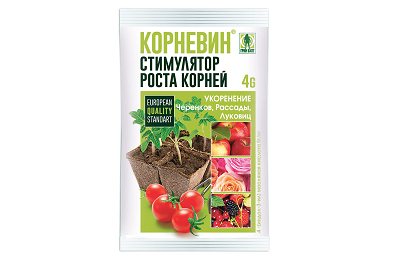

The ability to bear fruit for a long time also depends on the selected variety of this berry culture. But there are many long-term fruiting grapes. The choice is up to the growers.
The growing process can be accelerated, but only slightly. But in both it and in ordinary cultivation, the main thing is to take proper care of the planted grape bush. Protect him from diseases, heal. If the need arises.
All this must be done with love. And then the usual routine process will turn into an exciting and rewarding pastime. And the resulting harvest will be a worthy and tasty reward for your work.
Getting an early harvest. Additional methods
When planting a vineyard, focus on crop varieties that are distinguished by early fruiting. The following varieties can boast of these characteristics.
The bush is vigorous, with a well-ripening vine. Each shoot forms 2-4 inflorescences. Bunches weighing more than 3 kg have a pronounced branching, beautiful conical shape. The mass of one fruit is 4-5 g. Soft pink fruits with dense juicy pulp with a nutmeg flavor. You can get 4-6 kg of berries from one shrub.
The variety is high-yielding, fruitful, frost-resistant, will be a good decorative addition to the site.
Long
A versatile variety that ripens at the end of September. The growth force of the bushes is great. A bunch weighing 200 g has a conical shape, dense structure. Berry weighing up to 3 g, oval, yellow-green. The pulp is juicy with a pleasant taste.
The disadvantage of the variety is considered instability to frost and fungal infections, therefore, it requires a set of measures to protect against diseases and cold weather.
Isabel
Bushes of medium vigor, forming medium-sized brushes, weighing 2-2.5 kg, cylindrical in shape. Grape fruits weighing 3 g, round, black-purple in color with a thick bloom of gray-gray color. The skin is dense and durable. The pulp is pale green, sweet and sour with a taste reminiscent of strawberries. Harvesting takes place at the beginning of October. The first fruiting is observed in the 3rd year after planting of seedlings.
The variety is valued for its taste, low calorie content, high yield rates, and unpretentious growth. A versatile variety, it can be used both fresh and for the production of high quality wine and raw materials for various homemade preparations.
Kishmish
The bush forms shoots of great vigor, the vine ripens 2/3 of its length. The culture has large clusters, which can weigh up to 1 kg. Small pink berries have a characteristic waxy bloom and thin skin. Distinctive features of this variety are sweet taste and lack of seeds.
High yield and disease resistance make the variety attractive for cultivation.
Summer Muscat
Vine bushes have the ability to reach 3 m in height. The plant is decorated with bunches of cylindrical shape, friable, fruits weighing up to 8 g, painted in an amber color with a white tint. The pulp is juicy, sweet.
The variety is popular because of its yield, 40 kg of berries can be cut from one bush, early ripening and resistance to diseases and pests.
Noble
Bushes of high vigor with bunches in the shape of a cone, medium density, moderate looseness, weighing up to 700 g. Fruits weighing up to 16 g, green-yellow color with a dense skin, which is not felt when used. The pulp is characterized by meatiness, juiciness and pleasant nutmeg taste.
Fruiting is observed in the 3rd year after planting.
Augustine
A vigorous bush of grapes, forming conical brushes, weighing up to 600 g. Fruits of an elongated-oval shape, amber color, when fully ripe, acquire a blush on the sides. The mass of one fruit is 7 g. The pulp is dense, fleshy with a harmonious sweet taste without a pronounced aroma.
Augustine does not require special climatic conditions and bears excellent, stable fruit even in the most unfavorable regions.
Alyoshenka
The grape bush is characterized by strong vigor of growth. The bunch is distinguished by its elegance and loose structure. The weight of the bunch ranges from 0.8 to 2.7 kg.
Berries in the form of an oval, amber color with a light white waxy coating. The weight of each berry is 4-5 g. Crispy juicy pulp with a pleasant taste.
Harvesting takes place at the end of July. From one bush, you can get about 25 kg of a quality crop.
Varieties and their general productivity
The main characteristic of the variety is its yield. The description of any variety indicates to which category it belongs: to low yielding, medium yielding or high yielding.
The most productive varieties: Arcadia, Athos, Byzantium, Gourmet, Kishmish and other varieties with a bunch weight of 1 - 2.5 kg. On average, 10 - 25 kg of fruits are harvested from a bush.

